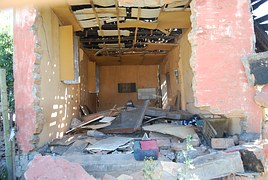A Disastrous Disaster Management Authority: Northeastern Earthquakes

An earthquake, with its epicentre 29 kilometers from Imphal, ravaged the city of Manipur on January 3rd. Its tremors were felt in states as far as Orissa and Jharkhand. With a magnitude of 6.7 this has undoubtedly been the second strongest earthquake in a history of 60 years in Manipur, with the strongest one having had a magnitude of 7.3. The final casualty of those injured was around 200 and 11 people were claimed dead.
The Cause
Manipur is located in seismic zone V which is quite sensitive to earthquakes. The resultant earthquake was due to the movement of the Indian plate towards the Eurasian plate which happens at the rate of two inches every year. This makes the regional boundary arc in northeast, called the Indo-Burmese arc, an active zone. One can attribute frequent though minor tremors in Manipur to this very reason. It is intelligible to assume that predictions and hasty warnings about the earthquake would have been issued only to pave way for last minute rescue operations.
Is the National Disaster Management Authority ill-prepared?
Considering the recent disasters in Uttarakhand, Chennai and Manipur though there have been improvements, the disaster management authority to a large extent is ill-prepared. NDMA was constituted as an apex body in 2006 to deal with disasters by undertaking projects in sensitive zones that would prevent large scale destruction and allocating funds for mitigation and relief work. However, since 2008 prominent posts in NDMA bear a vacancy of an eyesore. This just leaves one to hire temporary consultants to the seats. Every project undertaken by NDMA has either been aborted or was called off due to poor planning and design. In fact, according to a report by CAG, the National Disaster Management Authority has not properly monitored state agencies in their disaster prevention projects. This is due to the lack of communication between the central and state bodies. Improvements in post relief work over the years is the only notable change that one can grasp their straws at. However is this merely because of the help received from our commendable Army and Air force?
The cloud with the silver lining
The Army and Air Force commenced their relief operations soon after the earthquake subsided on January 5th. The National Disaster Response Force ensured that all debris were cleared and rescued people trapped underneath.In addition to this, their timely medical assistance stopped death rates from escalating.
In NDMA’s line of sight
While the Imphal Municipal Corporation has divided Manipur into different seismic zones and have directed guidelines for design of earthquake resistant structures, it has clearly not been implemented. It is of an especial importance that lifeline buildings like schools, hospitals and government buildings remain functional during disasters so that they can provide shelter. However, this was not the scenario both in the cases of the Chennai floods and the recent earthquakes. The lack of facilities in wards like ICU led to the death of patients who otherwise could have been treated. Likewise, emergency warning systems too must exist for timely evacuation of people concerned.
Moving ahead
For those who experienced the earthquake strike in its entirety, they were left surprised. Though they lived in a region where minor tremors seem to be the norm of the day, a tremor of this magnitude was only a tale that they had heard from their grandmothers about the earthquake of 1950. Those asleep claimed that they were shocked to find the ceiling just a feet above them upon waking up. Villages situated on hillsides collapsed for the huts were built with mud and loose bricks. It is depends on civilians like us to show the same spirit like we did during Chennai floods and support our Northeastern counterparts while they get back on their feet and brush off the dust of a bleak past.
[Image Attribute: jtrujilloc0 ]




